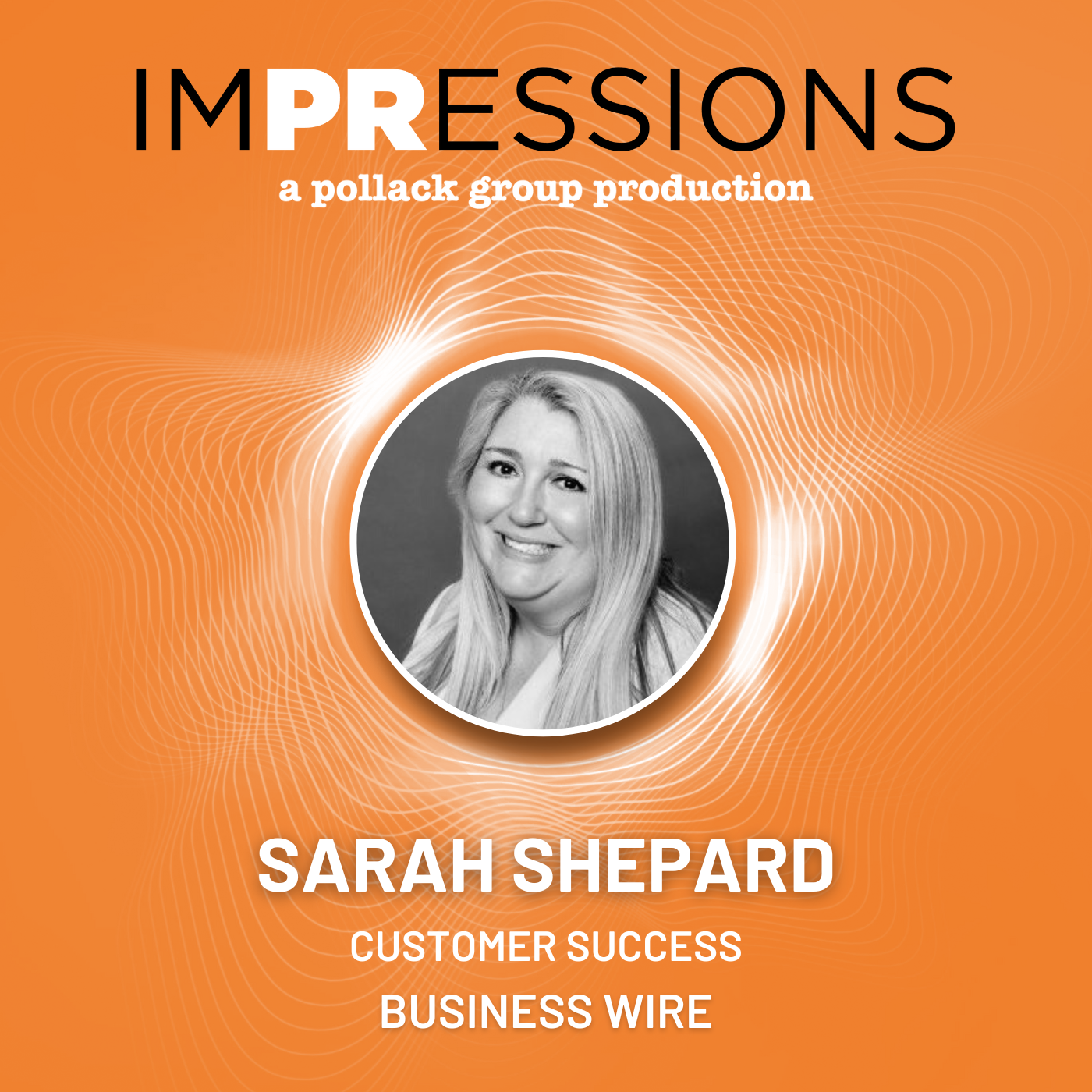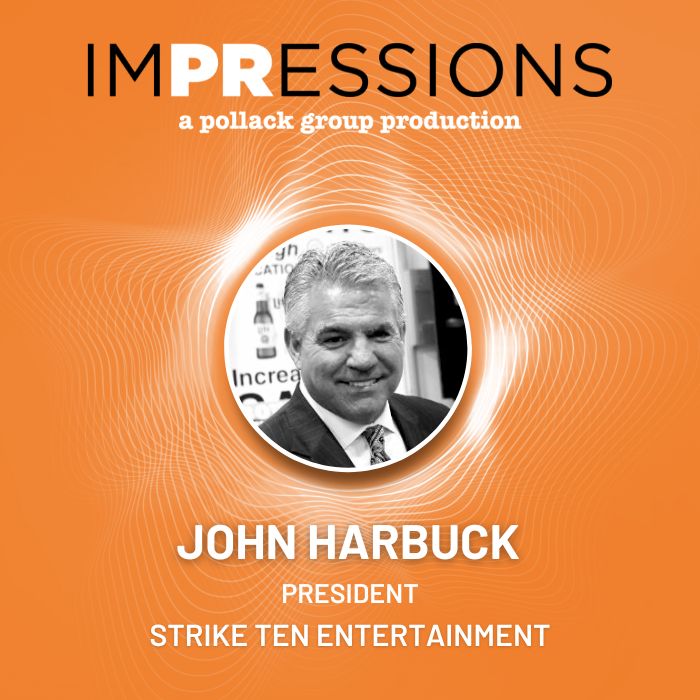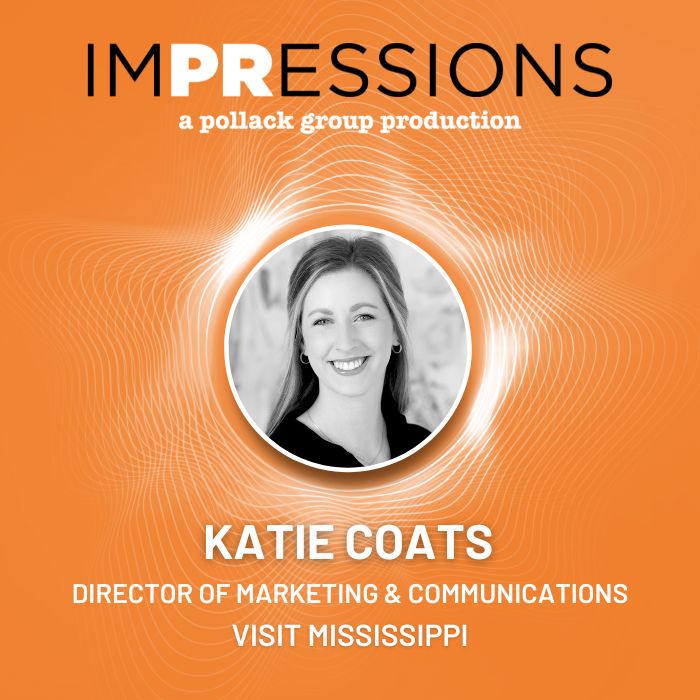 The press release: an antiquated practice or a necessary PR tactic? In episode 17 of imPRessions, Sarah Shepard from Business Wire details how the press release model has shifted with the onset of social media. Is distributing a press release still an integral part of the PR model? Can a successful company announcement or campaign prosper without deploying a news release? Tune in to find out!
The press release: an antiquated practice or a necessary PR tactic? In episode 17 of imPRessions, Sarah Shepard from Business Wire details how the press release model has shifted with the onset of social media. Is distributing a press release still an integral part of the PR model? Can a successful company announcement or campaign prosper without deploying a news release? Tune in to find out!
ImPRessions Episode #17 Transcript
Jenn: The press release is an official alert provided to members of the media to provide brand information or provide a company statement. Today, it is one of the most traditional components of public relations and has been a prominent core to the PR model. But with the onset of social media, where news travels at the speed of light, many specialists have pondered if the press release is still the communication staple it once was. To address this theory, we’ve invited Sarah Sheppard, who manages customer success at Business Wire and has been at the company since 2005, to help us answer the age old question: does a successful PR campaign still need a press release? Hi Sarah. So excited to discuss the subject with you today. Thank you for joining us.
Sarah: Thank you for having me. I’m glad to be here.
Kalli: Of course, of course. So I actually want to start out with a heavy hitting question and really just dive right into it. Our press release is still as effective today as they once were.
Sarah: Great question. And let’s go way back. Let’s go to the Wayback Machine a little bit here. The press release originally started in October of 1906.
Jenn: Wow, that far back. We’re going. We’re going way back. Yeah.
Sarah: October 1906. The first press release appeared in the New York Times, written by a gentleman who’s like the great grandfather by the name of Ivy Lee. And it was a statement at the time for tragic train accident on the Pennsylvania Railroad when they issued it, and when they posted it in the New York Times and print. What was the purpose of pressing of posting it at that time? Well, it was to prevent, you know, alternate versions of the story or the accident as appeared to appear across the press. They wanted authentic information in there, and they wanted the intent to be the real information so that the folks reading it can read about it and understand what happened when it occurred, who was affected, and it was important to get at that authentic information. So that was the beginning of the press release as it existed. And I think that as it appears today, the consistency of why a press release is written hasn’t changed much. It’s still a valuable resource to get at relevant information, to get at authentic information, and also to make sure that the information is getting out to the appropriate readers as vast and as widely as possible. The agency that I’ve worked for at the time had three basic points of what they did for their clients. One was authenticity, two accuracy, and third is interest. And if you read the press releases today that are issued, they basically are following those three basic principles authenticity, accuracy and interest.
Jenn: Interesting. So 1906. That’s quite an evolution to today’s world. You know, back in the day, press releases were mailed, right. The snail mail, they were faxed and now we upload them to a service like Business Wire, and it gets sent out to a mass distribution list of reporters. The digital world has really evolved and changed. How else have you have you seen it changed?
Sarah: It’s you know, there’s been a huge paradigm shift in communications and in the way that Business Wire delivers news and the way that clients are using the press release as a tool to get the information out there. Over the past 15-20 years, the biggest shift is we’re getting the information out there to sources. So it’s getting out to the New York Times. So, back in 1906, if Business Wire existed, Ivy League agency would probably have sent the release to us, and then we deliver it to the different news outlets that they wanted to target to get out there. But the content and the text would remain the same. I think what’s changed is the way the release is delivered. There’s no delay anymore when a release is being sent out, it’s sent out instantaneously and simultaneously to all audiences that the sender wants to reach blogs, industry, trade verticals. ET cetera. Think that what has changed? Also, if, for example, the intent was sent to the New York Times, the intent at the time was, ah, The New York Times hopefully will print the story. Well, now the outlets have morphed as well.
So they’re not only printing stories, they may take that story and repurpose it on a blog of theirs, or they may repurpose it in a magazine element to their publication, that they may have any other social profile that they may be managing as well. So think of that’s what’s changing. And also the reporters are changing. So they’re not only reporting the news, engaged on how many people have bought the publication or how much text space that they have on a printed publication. They’re also measured on, Is a story being repurposed? How many people are subscribing to them? How many people are viewing the article that may have also been posted on that company’s website? So I think that they’re taking the release and then broadly disseminating across all the mediums that that publication may have. And I think one of the other big movements is not only sending out a text press release, but also including multimedia. So it’s enhancing the overall storytelling. So, you know, if you say the old adage a picture tells a thousand words, well, same thing with the press release. If you’re sending out an announcement of a new hire, sending out with a photo, if you’re talking about a new product that’s being launched, for example, Apple, a big client of ours, when they’re sending out their new iPhones or a new system that they’re pushing out or new iWatch, they’re going to send it out with a photo. If a client is doing a new campaign, a launch of a new facility, they may be sending it out with a video to help tell the story. I think what’s also changed is we have clients that are using the Business Wire interactive media release, such as our client, Henry Schein, where they had a new initiative on their ESG and sustainability initiatives for Practice Green. So we worked with them on sending out an interactive press release which further illustrated their story, because it was a tool that someone can use to click through to learn more about their initiatives, hear from their management team about what they’re doing, and sign up and get more information. So you have many calls of actions within the press release itself today.
Jenn: We really take advantage of that because, you know, for the younger generations, there are so many ways to get your news out. Whereas back in the day, like you said, you fax it, you send it out in the mail today, it shows up in blogs like blogs weren’t a thing back. You know, thinking about the time before technology, before the internet. There was one release that went to, you know, X amount of publications, it ran it or it did it. It’s very fascinating. In a sense
Sarah: It is. And if you think about it also, even from a publicly traded company perspective, it used to be that the release would go out, let’s say, their earnings release, and would have their quarterly numbers. But back in, you know, the early 2000 or, you know, late 1990s, they would then print their earnings on, on a, you know, a trifold and then they would mail it out to their investment community and then the investors would get it. But by the time they got it, it’s weeks later after it was designed, after it was printed, after it was folded, after it was put an envelope and mailed, the next earnings release would already come out or the numbers. So it was already outdated by the time it was printed.
Kalli: Yeah. That’s it’s you know, it’s crazy when you think about it, especially like comparing it to today. Like we said, you know, the releases are going out, you know, right away. And, and I’m sure the amount of releases that are going out has increased as well because it’s it has become such an effective process. You know, what are some of the ways that writers can stand out when they’re writing a release? You know, what can companies do to kind of make their release stand out and grab that attention that they’re very clearly seeking when putting their news on the wire, the.
Sarah: First thing they need to think about is when they’re thinking about drafting a release and putting it out on the wire. I think they need to step back a bit. They need to step back and say, what audience am I trying to reach? A there’s so many different constituents, so who am I trying to reach? And I ask this of clients all the time, are you trying to reach investors? Are you trying to reach potential business partners? And then what type of announcement is it that you’re issuing? Are you doing a company rebranding? Are you announcing an award that your organization has received? Are you announcing an IPO, a product launch, a special event coming up? And I think once you figure out those two parts as why, what are you issuing and why, and then what audience you need to reach, then you could take that next step. So it’s then figuring out, okay, I know that this is audience I want to reach, and this is the message I want to get across. Now. Then you need to think about what geographic reach do I want it to go to, because we can help clients tailor reach as small of a market if they just want to reach, for example, Miami, or if they want to reach the Pacific Northwest, or if they want to reach national or international markets. Some clients want to reach, for example, metro New York and, you know, Asia Pacific region, the energy corridor within the United States, and Amea, for example. And then we work with them on selecting the specific trades. As a consumer, is it health care within health care? Is it biotech? Is it chemicals? Is it manufacturing or construction? We help them narrow it down with that targeted reach as well. And then from an amplification and a storytelling as we were speaking about earlier, is what can elements do you have to support that? Do you have an infographic that can help tell the story? Is there a photo? Is there a video to illustrate if there’s a new app coming out? Do you have a video showing what that app actually does? Because as you mentioned before, we have bloggers now. We have bloggers that can take that content and repurpose it. We have reporters that don’t only have the print space in. Their newspaper. They’re also responsible for filling some sections on their website, or if they’re tweeting out something or sharing it on social, they can use the graphics that you as a client send out a release, provide what it does. Is it make sure that the content that you’re pushing out when someone’s reading it is authentic? So you know, the purpose of using a wire distribution service such as Business Wire is we are membership organizations, so we vet all of our content to make sure it’s authentic. And it’s from, you know, an actual user. And I think today with all the fake news going out there, we really need to be careful of that. And then the second thing is knowing that the media knows that it’s authentic information from us. They’re most likely to trust it and then be able to repurpose it.
Jenn: Has that ever happened where you had like a rogue employee or something from another company, try to publish something that was not legitimate, and you had to kind of do your own PR because it went out and had to kind of backtrack?
Sarah: Well, you know, they’re always bad actors. If we, you know, we call them out there, right? So we have a whole process internally where we vet releases before when new accounts are coming in. So we, you know, stop a lot of accounts from even being set up because it doesn’t have the right qualifiers that we’re looking for.
Jenn: Right. Well, you gave a pretty great rundown of some of the ways that people can write a really powerful press release. And I know you kind of already talked a little bit about some of the added benefits that a program like Business Wire can provide. When I let’s say I set up my press release, and I pick my list, and I’m ready to go. Is there anything else from like The Business Wire end that might be able to amplify the press releases, reach additional lists, or maybe something that I’m not even quite sure exists?
Sarah: Absolutely. And that’s why we really stand out. We act as a true consultant with our clients. So we are here to be an adjunct to your team to help you figure out what the right reach is. So besides selecting the targeted geographic reach and the trades that are, you know, pretty straightforward. We have trade verticals available in automotive, in entertainment, in sports, in health care. And then we have further verticals. If you want to reach certain targeted audiences via our smart Brief distribution, where your release can actually get plugged into certain newsletters with opted in individuals who opt in to receive those newsletters based off of the industry categories that they’re interested in. We also have reach from a social media, I’m sorry, a corporate social responsibility, a CSR reach where if you have certain sustainability or ESG initiatives and you want to reach those influencers, we have that CSR initiative reach as well that goes out. And then for publicly traded companies, we can actually file and furnish your filings, you know, for Edgar filings to the SEC. So if you have a 10-q or 10-K, any other relevant filings, we can actually disclose and furnish those to the different, you know, SEC as well. And then after the release goes out, what we also work with you on is post-release. You get an extensive measurement report back called our News Track Reports, where you can actually see the reach, the engagement for the various audiences that you’ve delivered the news to. If you include hyperlinks within a release, you can see how many of those have been linked on and clicked on. And that’s more information for you to take a look at and understand what worked on a previous release, so you can better your next announcement.
Kalli: Now that makes a lot of sense. And you know, speaking of reach, has the rise of social media helped the press release distribution industry like, does it have an impact on how many people are seeing these releases?
Sarah: Yeah, another great question. And one of the other elements that we’ve added to our press releases, and thank you for prompting that, is being able for the client to include various social media features within the press release itself. So within the release, you can include when it’s displayed on business wire- when someone’s viewing it, you can include your social media pages. You can include LinkedIn, Facebook, Twitter. We actually integrate a Twitter handle whether your last three tweets are integrated into the sidebar of the release. But the advice is also to clients, in your boilerplate-you have a traditional boilerplate- I recommend adding in a sentence at the end of it with a call to action saying. Follow us on Instagram with a link to your Instagram page. Join our blog with a link to someone to subscribe to our blog, but use your boilerplate to drive that traffic and spur the engagement and spur the conversation. I think that as you ask, you know how social media has helped. It’s helped because people have that release that goes out traditionally, but then that’s only part of the puzzle. The rest of the puzzle is to take that release and repurpose it. Share it out on not only your personal pages, but have your client shared on their corporate Twitter page on their corporate LinkedIn page. ID share that actual release, because then you will able to see how many links went back to that release that’s been shared. And that will all come back on your measurement report as well. We see so many times the different news organizations from Yahoo, from New York Times, from all different large and small publications and blogs as well, that they’ll actually take that business wire link of the press release and include it in their article online. And I think sharing it out helps with the amplification of the release to all the different audiences and broadens the reach of it as well. And the reporting that you get back from us is cumulative for a two year period. So, you know, typically you see that bump up in the visibility report section within the first 24 to 78, 72 hours. But when the company shares it out and certain releases are evergreen, you can space that out. You can share it out next week, you could share it out two weeks later and different platforms and kind of work on a campaign in terms of how you’re going to share that content, and then that helps drive the long tail effect of the release. So you get more visibility over time as well. But remember, you know, it’s important to share that content across various platforms because you’re going to have different types of audiences that you want to reach as well. So an organization talking about an expansion, well, if they have their information or they’re looking to hire new folks, they might want to have a link to that expansion release in those platforms where they’re seeking employees just to show the growth of the organization as well.
Jenn: Yeah, and I think that’s a big step that people often neglect, the promotion of the press release. I’ve seen it with clients before, you know, it’s a service such as Business Wire is great, and it gets maybe 80% of the news out there or so, but you still got to promote your own business and promote your own news. So think that’s a really valid point to make. And a lot of people forget that when they’re, you know, working for a brand or working on the, the comms, as you said. So you’re obviously pro PR, pro press release, I should say, which is great. What do you say to somebody who says, you know what, I don’t see the benefit of sending out a press release about this news. In fact, don’t see the benefit of press releases anymore. What would you say to somebody who says that.? In your experience, what are the benefits of sending out a press release?
Sarah: Sure. So there are many benefits of it. I think one is, and I said it before, I’ll say it again, is getting out that authentic information. I had a situation many, many years ago where the major record label, they sent out a release, but they didn’t include a photo. And one of the major publications wrote about the announcement that they had in the release, but then used a photo from a record album that wasn’t an authentic one. And they came back to me the next week saying, what can we do here? I’m like, I told you, send it out with the record album itself so that someone who’s writing an article isn’t doing a search online, finding something that’s not authentic and it doesn’t match the story, and it’s not you know, a credible announcement. So one, it’s, you know, authenticity. Secondly, it helps build your brand awareness. I’d say a lot of times, for example, with the release, let’s say you’re a big retailer or a brand, send out an announcement and you’re talking about a new ad campaign, maybe in a major publication for this new fashion brand. We’ll send it out with imagery, send it out with maybe the commercial that goes alongside with it. And that helps with the visibility and the awareness of your brand, not only to the media, but to the various constituents that you want to reach as well. And again, it’s not just reaching the media. If you’re, you know, an organization with a new product that’s consumer facing, when you’re a consumer and you’re purchasing something or you’re going on a vacation and you’re interested in hotels, you’re probably searching that hotel name online, right? And you’re saying name of hotel, you know, name of city information. Well, if your press release is written with those keywords, especially high up in the release or throughout the release, when it’s most likely, then your release will then be in the search engine that is someone searching that and by the keywords are searching, it can come up. So the benefit of the press release sent out over wire services also indexing it in the search engine. So it’s a great way to do that. I think also it’s a great testimony to an organization. So if you’re talking about a new launch or if you have a customer quoted in the release or a partner quoted in the release as well, it builds excitement amongst, you know, the audiences that you’re trying to reach. And it’s showing the purpose of that announcement as well. I’d say also in, you know, there are lots of times where there’s unfortunate news that has to go out, right? It could be a crisis, it could be an incident, it could be something that you need to communicate that’s not a great thing. Then you’re escaping the rumor mill and then putting out your authentic information so someone can find it as well. Perhaps a company is delisting on the exchange or filing for bankruptcy, or, you know, there’s a crisis with an organization. Use the wire service to get that information out there because, again, you know, it’s authentic, and then you’re avoiding any kind of, you know, a self-told story about a company, but I think it moves over into, you know, managing the brand reputation and again and sharing that information out there.
Kalli: Yeah, it’s so true about how many benefits there are to sending a news release. And I’m just curious, where do you see the industry heading to continue to, you know, make this a really effective way to distribute news, and in your experience, how will press release distribution morph in the coming years?
Sarah: Yeah. Great question. And I’d say the first thing that came to mind when I’m talking about when think about the future of public relations and communications across the board, if we look back 15 years ago and you went into a room and you met with communications heads and you said, does anyone know what Facebook is? Does anyone know what Twitter is? Does anyone know what online social is? Nobody knew and everyone was scared of it. And I’d say, then look now, today, now. You can’t live without that. Now everybody knows what it is. And I’d say the next shift that we see in it is the big launch of AI and ChatGPT, you know, which rocketed since late fall. I’d say people will get smarter. I think they’re hearing about it, but they’re not. Deep dive into AI right now. But I think with AI and ChatGPT, it can only help the press release a little bit more. You can look at, you know, certain information. You can do certain prompts in ChatGPT to follow trends, or maybe it’s about a certain industry sector, and you could put a prompt in saying, you know, what are the different trends in the oil and gas industry today? Or what’s the concerns of the oil and gas industry, for example? And you can use that and do those prompts. And then when you’re writing a release, you can say, “oh, let me leverage that and let me talk about these topics because I’m representing oil and gas company and here I could see what the trends are, and here I can see what the concerns are.” So let me work with, you know, the team on writing releases to address that or to integrate it. And I’d say with social media, it’s such a big part of everything that everyone does. And you said it earlier, one of you said, I don’t remember who it was, It’s amazing how many times a client will send out a release but then doesn’t share it out. I watched a webinar about ChatGPT by an agency and they said something so smart. They said once you have your release, you can use then a ChatGPT say prompt it out, saying, write me a headline for this release that I can use on LinkedIn. This will really help speed up the process of getting that release repurposed out there. In terms of the future, there has to be more of a communication between marketing and PR. There is sometimes that blur between and they’re not talking to one another, and they’re not sharing the same content on a timely basis to customize it, to personalize it to the right audiences and push it out. And I’d say the other trend is making them interactive. As I talked to you before about that example that I mentioned for Henry Schein with the interactive press release, making the content interactive and shareable. And most importantly, is for someone to look at a press release and when they’re writing it, it’s not just a press release, but think of it as a microsite. So think of it as a web page of content they’re preparing. So when someone’s reading that press release, you’re spoon-feeding that information to the reader so that they don’t have to look for the content or look for more information. So, for example, if there’s a quote from someone, from a president of a, of an organization with interlace behind their name, put a link back to their bio on their website that keeps it authentic, keeps it contained, and that the reader who’s consuming that news doesn’t have to look elsewhere. So those are simple, simple things to do within the body of the release that a majority of folks still aren’t taking advantage of. And that starts from who’s writing the release and that word document before it’s sent out. So think it’s looking at that release holistically and saying, where can I grow the biggest impact? And then after it’s gone out, have I repurposed it the right way and then have really taken the time to do a deep dive into the analytics to see how it fared, to see where it’s maybe been reposted on social, what influencers are sharing the content.
So you really have to take all everything together and then have the next step. It took about 15 years to learn all about the social stuff, and now we’re learning about this next phase. We’re learning about ChatGPT, we’re learning how to implement AI, and I think that’s the future that we are morphing into right now.
Jenn: I completely agree. As I said before, it’s kind of amazing to live in today’s day and age with so many tools at our disposal to be able to amplify press releases. So we have social media. I mean, back in the day, these things were unheard of. Nobody ever thought that we would live in this day and age. So, I mean, I think there you have it. You know, there really is nothing antiquated about the press release. In fact, it’s still a crucial asset to keeping the media informed of company news and movement. So thank you so much for the great conversation today, Sarah.
Sarah: No, you’re very welcome. It was my pleasure, and I look forward to seeing it morphing. And let’s, you know, let’s pencil in a date to see how everything’s performed in the future.
Jenn: Absolutely, absolutely. For those of you at home, thanks for tuning in. Got a question for Kalli or myself? Email us anytime at impressions@pollackgroup.com.






